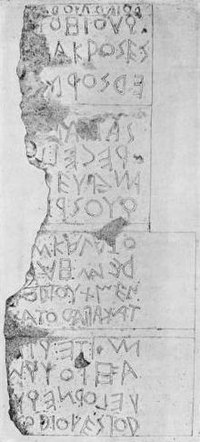 | Luwian (/ˈluːwiən/), sometimes known as Luvian or Luish, is an ancient language, or group of languages, within the Anatolian branch of the Indo-European... 39 KB (4,512 words) - 21:24, 17 April 2024 |
The Luwians /ˈluːwiənz/ were an ancient people in Anatolia who spoke the Luwian language. During the Bronze Age, Luwians formed part of the population... 17 KB (1,781 words) - 00:32, 16 April 2024 |
 | Hieroglyphic Luwian (luwili) is a variant of the Luwian language, recorded in official and royal seals and a small number of monumental inscriptions.... 12 KB (1,352 words) - 17:06, 23 April 2024 |
 | Anatolian hieroglyphs (redirect from Luwian language hieroglyphs) known as Hittite hieroglyphs, but the language they encode proved to be Luwian, not Hittite, and the term Luwian hieroglyphs is used in English publications... 61 KB (1,627 words) - 07:07, 16 April 2024 |
was part of the Luwian language family. However, only a few words can be derived from Luwian roots, like maśara 'for the gods' (Luwian masan(i)-, 'god'... 14 KB (1,135 words) - 22:54, 8 April 2024 |
 | Boustrophedon (category Articles containing Ancient Greek (to 1453)-language text) original wooden type). The Luwian language had a version, Hieroglyphic Luwian, that is read in boustrophedon style (most of the language was written down in... 12 KB (1,300 words) - 05:30, 27 March 2024 |
derived from Luwian and thus Indo-European. Isaurian names containing clear Anatolian roots include Οαδας Oadas, Τροκονδας Trokondas (cf. Luwian Tarḫunt,... 3 KB (254 words) - 06:23, 10 April 2024 |
 | Hittites (category CS1 French-language sources (fr)) family; along with the closely related Luwian language, it is the oldest historically attested Indo-European language. The history of the Hittite civilization... 96 KB (11,240 words) - 08:00, 20 April 2024 |
 | Crete (category Articles containing Cuneiform Luwian-language text) Its etymology is unknown. One proposal derives it from a hypothetical Luwian word *kursatta (compare kursawar 'island', kursattar 'cutting, sliver')... 104 KB (10,609 words) - 00:58, 6 May 2024 |
Anatolian Verbal Stem Formation: Luwian, Lycian and Lydian. Netherlands, Brill, 2020. The Indo-European Language Family: A Phylogenetic Perspective... 7 KB (741 words) - 23:04, 6 April 2024 |
 | Gyges of Lydia (category Articles containing Cuneiform Luwian-language text) evolved Hittite ḫuḫḫa- (𒄷𒄴𒄩), Luwian ḫūḫa- (𒄷𒌋𒄩) and huha- (𔕳𔓷), and Lycian xuga- (𐊜𐊒𐊄𐊀) in the Anatolian languages family, as well as Latin avus... 34 KB (3,974 words) - 23:31, 6 March 2024 |
 | Cappadocia (category Articles containing Turkish-language text) Persian name is Katpatuka. It was proposed that Kat-patuka came from the Luwian language, meaning "Low Country". Subsequent research suggests that the adverb... 45 KB (4,624 words) - 20:41, 27 April 2024 |
 | Tyana (category Articles containing Hieroglyphic Luwian-language text) Hittite Empire, and Tuwana (𔑢𔗬𔐤𔔂) in the Luwian language during the Syro-Hittite period. From the Luwian name Tuwana were derived the Neo-Assyrian Akkadian... 34 KB (3,569 words) - 20:45, 26 April 2024 |
 | Bodrum (category Articles containing Hieroglyphic Luwian-language text) cognate with Luwian word "ha+ra/i-na-sà", which means fortress. If so, the city's ancient name was probably borrowed from Carian, a Luwic language native to... 48 KB (4,374 words) - 14:06, 16 April 2024 |
Tarḫuntašša (category Articles containing Hieroglyphic Luwian-language text) the ancient Luwian characters in this article correctly. Tarḫuntašša (Hittite: 𒀭𒅎𒋫𒀸𒊭 dIM-ta-aš-ša "City of Tarhunt"; Hieroglyphic Luwian: 𔖖𔓢𔕙𔑯𔗦... 14 KB (1,859 words) - 16:35, 5 January 2024 |
 | probably falls outside the centum–satem division; for instance, the Luwian language indicates that all three dorsal consonant rows survived separately... 48 KB (5,862 words) - 23:20, 29 April 2024 |
BC. In the context of Luwian Studies, Luwian, however, is a toponym encompassing peoples of different ethnicity and languages. It is thus an abstract... 14 KB (1,546 words) - 11:41, 31 January 2023 |
 | Name of Syria (category Articles containing Hieroglyphic Luwian-language text) interest, both among ancient writers and modern scholars. In early Hittite, Luwian, Cilician and Greek usage between the 9th century BC and 2nd century BC... 28 KB (2,895 words) - 14:31, 22 April 2024 |
certain that there was one single language used in the city at the time. One candidate language is Luwian, an Anatolian language which was widely spoken in Western... 15 KB (1,696 words) - 06:04, 25 January 2024 |
 | Warpalawas II (category Articles containing Hieroglyphic Luwian-language text) Warpalawas II (Hieroglyphic Luwian: 𔗬𔖱𔕸𔓊𔗬𔗔, romanized: Warpallawas) was a Luwian king of the Syro-Hittite kingdom of Tuwana in the region of Tabal... 22 KB (2,231 words) - 20:48, 26 April 2024 |
 | Syro-Hittite states (redirect from Luwian-Aramean states) Neo-Hittite, Syro-Hittite (in older literature), or Luwian-Aramean (in modern scholarly works) were Luwian and Aramean regional polities of the Iron Age, situated... 21 KB (2,317 words) - 00:31, 16 April 2024 |
I-mutation (category Articles containing German-language text) languages, it is referred to as affection.[citation needed] A type of i-mutation is also observed in Anatolian languages, including Hittite, Luwian,... 7 KB (874 words) - 15:43, 6 April 2024 |
 | Miletus (category Articles containing Greek-language text) Minor from c. 1450 to 1100 BC. The 13th century BC saw the arrival of Luwian language speakers from south central Anatolia calling themselves the Carians... 37 KB (4,286 words) - 23:43, 14 April 2024 |
block containing Anatolian hieroglyphs, used to write the extinct Luwian language. The following Unicode-related documents record the purpose and process... 4 KB (76 words) - 19:53, 28 July 2023 |
 | Carchemish (category Articles containing Hieroglyphic Luwian-language text) structures, temples, palaces, and numerous basalt statues and reliefs with Luwian hieroglyphic inscriptions. Between 1956 and 1998, the whole site had been... 41 KB (4,810 words) - 15:57, 6 May 2024 |




